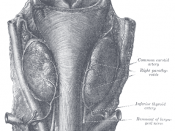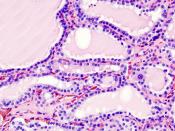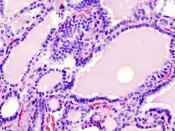The thyroid gland is located in the front, lower part of the neck, below the larynx. The small, two inch gland, consists of two lobes, one on each side of the trachea, connected by a thin strand of thyroid tissue, the isthmus. The parathyroid glands, small and oval-shaped, are located in each corner of thyroid gland lobes. Occasionally, people are born with one or more parathyroid glands inside the thyroid, inside the thymus, or somewhere else in the chest. Even when the glands aren't found right outside the thyroid, they continue to function normally.
Thyroid tissue consists of two types of cells: follicular and parafollicular cells. The majority of the thyroid is made up of follicular cells, which give off thyroxin and triiodothyronine (T3 and T4). These hormones contain iodine, which the thyroid needs to produce the hormones. The second type of cell in the thyroid, the parafollicular cells, give off the hormone calcitonin.
Thyroxin and triiodothyronine stinulate tissues in the body to produce protein and to increase the amount of oxygen used by cells. The harder the cells work, the harder the organs work. The calcitonin works with parathyroid hormine to regulate calcium levels in the body. The levels of hormones the thyroid secretes are controlled by the pituitary gland's thyroid stimulating hormone, controlled by the hypothalamus.
Parathyroid glands secrete parathyroid hormone. This hormone helps the body maintiain a balance of calcium and phosphorus. Parathyroid hormones regulate the use of calcium in the body and the absorption of food in the intestines. The hormones released by these two glands help to keep the body in homeostasis by controlling calcium usage, digestion, and how quickly the body reacts to changes.
There are a variety of diseases related to the thyroid and the parathyroid glands. Some of them...


